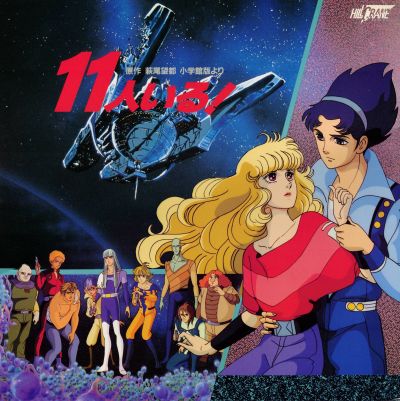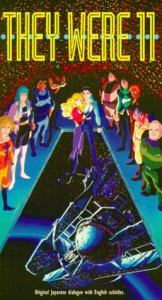
Jūichi-nin Iru! (They Were 11), directed by Satoshi Dezaki and Tsuneo Tominaga. 91 minutes. November 1, 1986.
 They Were 11 is a debatable OAV, since it was originally released theatrically in 1986 by Toho Films, produced by Kitty Enterprises (best-known for Urusei Yatsura) and Victor Company of Japan. However, it was one of several anime films that everyone recognized were really produced for the new home video market. It was rereleased as a video almost immediately.
They Were 11 is a debatable OAV, since it was originally released theatrically in 1986 by Toho Films, produced by Kitty Enterprises (best-known for Urusei Yatsura) and Victor Company of Japan. However, it was one of several anime films that everyone recognized were really produced for the new home video market. It was rereleased as a video almost immediately.
It was a prestigious manga novel first. It was as famous for its author as for its story, which was a skillful blend of science-fiction and mystery. Ten graduating interstellar space cadets, not all humans, are assigned to an old, decommissioned spaceship to survive on their own. The longer they last without calling for help, the higher their grade will be. They realize immediately that there are eleven of them – one is a ringer. But why? Is he planted just to secretly watch and grade them, or to create minor and not so minor sabotages to make their mission harder? Is he out to get them disqualified on a technicality? The cadets put themselves into danger by refusing to call for help and continuing to try to solve their situations on their own past the point where their instructors expected them to give up.
The 1975 manga novel by Moto Hagio was one of the first in the shonen “boys’ adventure” genre by a woman. Women had previously been relegated to creating “shōjo” manga for girls, usually flowery romances. Hagio and her colleague Keiko Takemiya were largely responsible for establishing that women could create manga in all genres, and for inventing the “yaoi” genre of male and female homosexuality which became massively popular with adolescent girls. Hagio’s They Were 11 manga won the 1976 Shogakukan Manga Award in the boys’ manga category.
 In the far future, Earth has achieved interstellar spaceflight through warp-navigation and met several alien peoples. After centuries of warfare, an Interstellar Alliance is formed, with Terra (Earth), Savan (Sava), and Sibberies (Seguru) as the leading stellar nations. 120 years ago, the IA created the elite Cosmo Academy to train the leaders of the future.
In the far future, Earth has achieved interstellar spaceflight through warp-navigation and met several alien peoples. After centuries of warfare, an Interstellar Alliance is formed, with Terra (Earth), Savan (Sava), and Sibberies (Seguru) as the leading stellar nations. 120 years ago, the IA created the elite Cosmo Academy to train the leaders of the future.
The latest class of the Cosmo Academy is approaching its final examination. The cadets are separated into groups of ten. That of Tadatos Lane, the young protagonist, is assigned to a derelict spaceship, the Esperanza, to survive for 53 days on their own, to solve the problems set for them. But there are eleven of them, creating doubt that they are meant to succeed. Are all of the problems that they encounter part of the tests planned by the CA for them, or are they sabotage by the mysterious eleventh to make them fail? Tadatos, an esper, finds that most of the others’ suspicion is falling on him.
The cadets, as they introduce themselves, are:
 Tadatos Lane. A Terran raised on Sibberies. He has some ESP talent; he can tell when someone is speaking the truth – or what he believes.
Tadatos Lane. A Terran raised on Sibberies. He has some ESP talent; he can tell when someone is speaking the truth – or what he believes.
King Mayan Baceska, a royal Savan of the planet Aritosca La. He is used to taking command and is afraid of failing. He is not an ESPer and distrusts Tadatos.
Doricas Soldam IV, a.k.a. Fourth. A Savan aristocrat, he sides with King Mayan.
Amazon Carnais. A commoner from Terra, and proud of it.
Chako Kacka. A Terran from the planet Ques. An opportunist who joins the Savans.
Dolph Tasta, a.k.a. Rednose. A Terran from the planet Peroma. A peacemaker.
 Toto Ni. A Savan from the planet Mis. Small and timid. Not telepathic but strongly empathic.
Toto Ni. A Savan from the planet Mis. Small and timid. Not telepathic but strongly empathic.
Frolbericheri Frol. From the unaligned planet Vene. A small size, light voice, and long blond hair makes Frol look female, but an argumentative and abrasive personality casts this in doubt. Is Frol male or female?
Vidmenir Knume, a.k.a. Knu A nonhuman from the planet Vidknu. Calm and logical.
Ganigas Gagtos, a.k.a. Ganga. A Savan from the planet Toledolega. Friendly.
Glenn Groff, a.k.a. Thickhead or Mule. Another nonhuman, from the planet Ashwhite. A frequent volunteer.
In addition to their test, the cadets wonder why the Esperanza became a derelict. What was its original mission, and why did it fail? Does the reason have anything to do with their present situation? And why 53 days, rather than 50 days or 60 days? 53 seems like an odd number. Is it a clue?
Personally, I wondered if cadets who are among the elite of the Cosmo Academy would be that ignorant of the other peoples and planets of their fellow cadets. But it’s a good mystery. How much of it can you solve?
Dubbed
Subbed
Next week: “Forgotten” OAVs #25


 Fred Patten (1940-2018) was an internationally respected comics and animation historian. He has written about anime or comic books for publications ranging from Animation Magazine and Alter Ego to Starlog. He was a contributor to The Animated Movie Guide (2005), and is author of Watching Anime, Reading Manga (2004, Stone Bridge Press), a collection of his best essays, and Funny Animals and More (2014, Theme Park Press), based upon his early columns here on Cartoon Research. He passed away on November 12th, 2018.
Fred Patten (1940-2018) was an internationally respected comics and animation historian. He has written about anime or comic books for publications ranging from Animation Magazine and Alter Ego to Starlog. He was a contributor to The Animated Movie Guide (2005), and is author of Watching Anime, Reading Manga (2004, Stone Bridge Press), a collection of his best essays, and Funny Animals and More (2014, Theme Park Press), based upon his early columns here on Cartoon Research. He passed away on November 12th, 2018.





































Leave a Reply